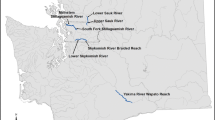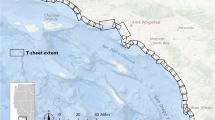Abstract
Increasing recognition of the value of tidal wetlands has led to interest in how to restore and enhance areas that have been modified by human activity. The policy of recognizing restoration or enhancement as mitigation for destruction of other wetlands is controversial. Once policy questions are separated from technical questions, the steps in a successful project are straightforward A key element in the design of a successful project is quantitative hydraulic and hydrologic analysis of alternatives. Restoration projects at two sites in California used a combination of empirical geomorphic relationships, numerical modeling, and verification with field observations. Experience with these and other wetland restoration projects indicates the importance of longterm postproject monitoring, inspection, and maintenance
Similar content being viewed by others
Literature cited
CH2M Hill and Tekmarine. 1988. Batiquitos Lagoon enhancement project Draft preliminary design report, Vol. I, technical report. San Diego, California.
Coats, R., C. Farrington, and P. Williams. 1987. Enhancing diked wetlands in coastal California. Pages 3688–3700in O. T. Magoon, H. Converse, D. Minor, L. T. Tobin, D. Clark, and G. Domurat (eds.), Coastal zone '87. Proceedings: Fifth symposium on coastal and ocean management. Seattle, Washington. ASCE, New York, New York.
Demgen, F. C. 1989. A review of 18 wetland mitigation sites in the San Francisco Bay Region. Pages 318–322in J. Kusler, G. Brooks, and S. Daly (eds.),Urban Wetlands. Proceedings of the National Symposium on Urban Wetlands and Riparian Habitat. Association of State Wetland Managers, Inc. Berne, New York.
Dennis, N. B., and M. L. Marcus. 1983. Status and trends of California wetlands. Prepared for the California Assembly Resources Subcommittee on Status and Trends. T. Goggin, Chairman. ESA/Madrone, Novato, California.
Fisher, H. B. 1970. A method for predicting pollutant transport in tidal waters. Water Resources Center Contribution No. 132. University of California Hydraulic Engineering Laboratory, College of Engineering, Berkeley, California.
Garbisch, E. W., Jr. 1986. Highways and Wetlands: Compensating Wetland Losses. US Department of Transportation Federal Highway Administration Report No. FHWA-IP-86-22. McLean, Virginia. 65 pp.
Haltiner, J., and P. Williams. 1987a. Slough channel design in salt marsh restoration. Pages 125–130in K. M. Mutz and L. C. Lee (eds.), Wetland and riparian ecosystems of the American West: Eighth annual meeting. Society of Wetland Scientists, Wilmington, North Carolina.
Haltiner, J., and P. Williams. 1987b. Hydraulic design in salt marsh restoration. Pages 293–299in J. A. Kusler and G. Brooks (eds.), National symposium: Wedand hydrology. Association of State Wetland Managers, Berne, New York.
Harris, D. L. 1981. Tides and tidal datums in the United States. Special Report No. 7. US Army Corps of Engineers, Coastal Engineering Research Center. Ft Belvoir, Virginia. 381 pp.
Harvey, H. T., and M. N. Josselyn. 1986. Wetlands restoration and mitigation policies.Environmental Management 10:(5):567–569.
Harvey, H. T., P. Williams, and J. Haltiner. 1982. Guidelines for enhancement and restoration of diked historic baylands. San Francisco Bay Conservation and Development Commission, San Francisco, California. 38 pp.
Hopkinson, C. S., R. L. Wetzel, and J. W. Day, Jr. 1988. Simulation models of coastal wetland and estuarine systems: Realization of goals. Pages 67–97in W. J. Mitsch, M. Straskruba and S. E. Jorgensen (eds.), Wedand modelling, Developments in Environmental Modelling 12. Elsevier, New York.
Johnson, J. W. 1973. Characteristics and behavior of Pacific Coast tidal inlets.Journal of Waterways, Harbors and Coastal Engineering Division, ASCE 99(3):325–339.
Jordan, W. R. III, R. L. Peters II, and E. B. Allen. 1988. Ecological restoration as a strategy for conserving biological diversity.Environmental Management 12(1):55–72.
Josselyn, M., J. Zedler, and T. Griswold. 1989. Wetland mitigation along the Pacific Coast of the United States.in J. A. Kusler and M. E. Kentula (eds.), Wetland creation and restoration: The status of the science, Vol. I: Regional reviews. Environmental Research Laboratory, Corvallis, Oregon. EPA/600/3-89/038a (in press).
Krone, R. B. 1982. Engineering wetlands: Circulation, sedimentation, and water quality. Pages 51–58in M. Josselyn (ed.), Wetland restoration and enhancement in California. Proceedings of workshop at California State University, Hayward. California Sea Grant College Program Publ. Report No. T-CSGCP-007.
Myrick, R. M., and L. B. Leopold. 1963. Hydraulic geometry of a small tidal estuary. US Geological Survey Professional Paper 422-B.
O'Brien, M. P. 1931. Estuary tidal prisms related to entrance channel areas.Civil Engineering 1(8):738–739.
Race, M. S. 1985. Critique of present wetlands mitigation policies in the United States based on an analysis of past restoration projects in San Francisco Bay.Environmental Management 9:71–82.
Rowan, M. E., and J. P. Heaney. 1988. Spreadsheet simulation of the hydrology of impounded salt marshes. Pages 265–279in Proceedings of symposium on coastal water resources. American Water Resources Association, Bethesda, Maryland.
San Francisco Bay Conservation and Development Commission. 1988. Mitigation: An analysis of tideland restoration projects in San Francisco Bay. Staff Report. San Francisco, California. 74 pp.
Shalowitz, A. 1964. Shore and sea boundaries, interpretation and use of coastal and geodetic survey data, vol. 2. US Department of Commerce, US Coast and Geodetic Survey. Washington, DC. 749 pp.
Williams, P. B., and M. L. Swanson. 1987. The Tijuana Estuary enhancement plan hydrologic analysis. Report prepared for the San Diego State University Foundation. 50 pp.
Zedler, J. B. 1984. Salt marsh restoration: A guidebook for Southern California. California Sea Grant College Program.
Zedler, J. B. 1988. Salt marsh restoration: Lessons from California. Pages 123–138in J. Cairns, Jr. (ed.), Rehabilitating damaged ecosystems, vol. I. CRC Press, Boca Raton, Florida.
Zedler, J. B., J. Covin, C. Nordby, P. Williams, and J. Bolland. 1986. Catastrophic events reveal the dynamic nature of salt marsh vegetation in southern California.Estuaries 9(1):75–80.
Author information
Authors and Affiliations
Rights and permissions
About this article
Cite this article
Coats, R., Swanson, M. & Williams, P. Hydrologic analysis for coastal wetland restoration. Environmental Management 13, 715–727 (1989). https://doi.org/10.1007/BF01868311
Issue Date:
DOI: https://doi.org/10.1007/BF01868311




